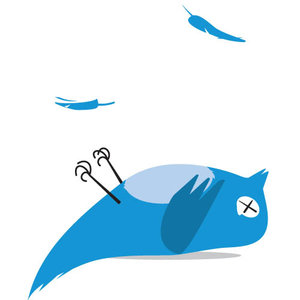It started slowly. In the beginning, it was new and exciting. You had fun together. You spent all your time together. Then, it turned into a job. All work and no play. Pleasure turned business.

You hated to admit it, but the thrill was gone.
You and Twitter should see other people.
Michaila McGee used to check Twitter every ten minutes back in 2012. The first-year St. Thomas University student jumped on the bandwagon to get the freshest news and follow her favourite actors. She even had two accounts. She checked the app on her phone so often she ended up with a $250 bill.
But after a year, the honeymoon was over.
“It’s like something shiny and new, but then it starts to get dull,” said McGee. “It just gets so annoying. You start getting a lot of the same thing.”
Twitter’s user base isn’t dwindling – more than 280 million people are active on the site with more jumping in every day – but those users aren’t as active as they once were. Twitter quickly became a tool for marketing and networking, but as its practicality rose, tweeters like McGee who were just in it for fun started checking in less. She still uses it for work, like almost everyone else, but she no longer has a personal account.
Heather MacLean never saw Twitter as a place to go for fun. MacLean, a STU communications lecturer and owner of the communications firm TaylorMade Solutions, has both a personal and a professional account that she uses daily. But with her personal account, she doesn’t tweet jokes or follow celebrities. She builds her personal brand and expands her influence in her industry.
“I consider my personal [account] as an extension of who I am and my brand,” said MacLean. “It depends on what you’re trying to use it for.”
MacLean has more than 5,000 followers and uses lists to distill her Twitter experience. She understands the platform in a way many others, like her clients and students, don’t. For MacLean, that’s the biggest problem: people just don’t get it. Who to tweet, what to tweet, when to tweet and the whole point of tweeting eludes many. If all you do is tweet selfies and follow @KatyPerry and @FillWerrell, you might find the experience lacking.
Which might be why the younger generation isn’t flocking to Twitter like they used to. In the last two years, teens and young adults started picking up Instagram, Vine and Snapchat instead of Twitter – anything with pictures instead of words. On Google Trends, searches about Twitter hit a peak in late 2012, early 2013 and have been edging downward since. But where Twitter starts to drop, Instagram, Snaphat and Vine start to climb. If a picture is worth a thousand words, it can probably manage 140 characters.
“There’s always new networks emerging, so people are finding those and trying them out,” said MacLean. “But you only need so many networks. You can’t maintain them all. And the younger demographic, especially the teenagers, are gravitating more toward the visual.”
Jonathan Munn uses Twitter for the same reasons as MacLean, even though he’s only a fourth-year STU student. He joined in 2010 and he tweets news, his photography and his location with his nearly 900 followers anywhere from 10 to 40 times per day. He’s figured out the formula. But even Munn gets that it’s not as romantic as it once was.
“When I joined Twitter…it was a cool, trendy idea that you could interact with anyone at any time,” he said. “But then it just turns into a thing. It turns into something that’s always been there and it turns more into a communications tool than a cool trend.”
Like MacLean, Munn thinks Twitter is only useful if you’re doing it right. If you’re looking for the same interaction – and ego-grooming – you’d get on Facebook, you’re looking in the wrong place. Part of Twitter’s initial appeal was that it’s a more streamlined experience than Facebook, but now it just looks like it’s offering less. MacLean always tells her students to get on it for their careers, not for fun, and to keep it up once they get rolling.
“It’s like exercise – once you start it, you have to keep going,” she said. “If you’re going to do it, do it well. Otherwise, don’t bother.”
But Twitter needs to put in the effort to reignite the spark too. If users face a daily barrage of promoted tweet and advertisements, they’ll be turned off, said MacLean. Twitter needs to strike a balance between staying afloat financially and driving away their customers. It shouldn’t dump what little fun it has left.
“People have been predicting its demise since 2009,” said MacLean. “But if they make it difficult [to communicate] and it’s all about advertising, then you’ll see people pull away. It still has to be fun in some aspects.”

